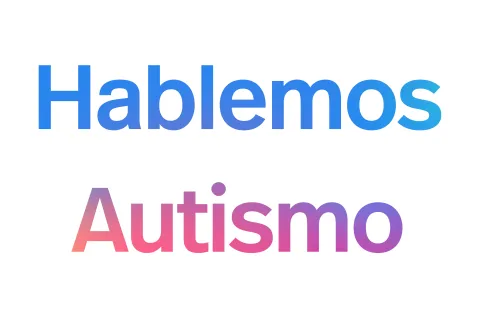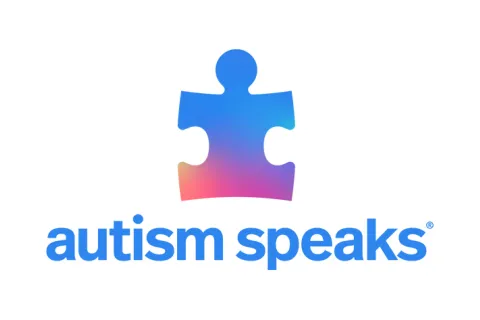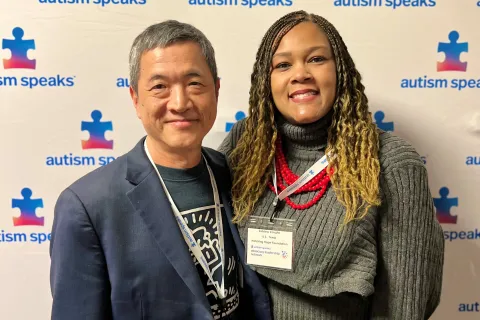Joint attention and autism
Parents seek autism-savvy advice on getting 3-year-old to interact
By Dr. Barbara BraddockThis response is from speech-language pathologist Barbara Braddock. Dr. Braddock practices at the SSM Cardinal Glennon Medical Center of the Saint Louis University School of Medicine. The center is one of 14 sites in the Autism Speaks Autism Treatment Network (ATN).
Our 3-year- old was recently diagnosed with autism. We know it’s important to encourage him to interact with us, but we don’t know how. When I point to something, he pays no attention. He rarely points to show me something, and when he does point, he doesn’t look at me when he does it.
Joint attention and autism
This is a question I often hear in my practice. You're describing difficulties in what we call “joint attention.” Joint attention involves the behaviors we use to share information with others. Typically, before children learn to talk, they start using behaviors such as eye gaze, gesture and vocalization to share interest in objects and events around them.
Typically developing young children use gestures such as pointing to something of interest or holding up an object for another to see. In addition, they may pair words or nonverbal sounds with their gestures. Conversely, they begin paying attention when other people make bids for their attention – even following another person’s gaze to see something of interest.
As you’ve noticed with your son, many young children who have autism fail to demonstrate these behaviors or the behaviors look noticeably different from what we might expect.
I encourage you to work closely with your son's developmental specialists on this issue. Ask them for suggestions of activities that would be particularly appropriate for you and your son to share at home. Before I share some general tips, it may help to break down the two sides of this important social behavior.
Responding to a bid for joint attention
Typically, this involves a young child responding to your words and/or looking at your eyes or gestures, then shifting his attention to the object or activity you are showing him.
Initiating joint attention
Conversely, a child can initiate joint attention by making eye contact and then gesturing or looking at something of interest. The child might also make sounds or say a few words that show interest.
So, what happens when a child lacks these social communication behaviors? Where do you start?
Combining professional intervention and parent support
The good news is that research has shown us that therapists and parents can foster joint attention in young children who have autism – using the principles of behavioral intervention.
If you haven’t already, I urge you to request therapy aimed at helping your son develop this skill through your state’s early intervention program.
Suggestions to foster joint attention at home:
- Respond to movements that signal interest: I encourage you to watch your child and respond to movements that indicate interest. Do so even if he’s not deliberately using these movements to communicate with you. For example, you see your son reaching for a toy – perhaps a toy just out of reach. Promptly respond by saying something along the lines of, “I see the toy, too. Would you like to have it?"
- Does your son sometimes hand you something? Respond to this warmly as a nonverbal sign of communication. For example, “Thank you for showing me this ball. It’s so squishy, isn’t it?”
- Praise any effort your son makes to show or share something. For example, if your child holds an object up for you to see, respond with appreciation, such as, “Oh, yes, I see the toy car. I like it. Do you?”
- Similarly, respond with clear interest if your son points at something – whether or not he looks at you. For example, you might mirror his movement by pointing at the same thing, then name it and ask about his interest. As in, “Yes, I see the pretty flower. Do you want to touch it?”
- In other words, you can share your interest in many ways – through your voice, your eyes, gestures and turning your body to face your child.
- Encourage your child to respond to gesture and words: A fun strategy we often use in speech therapy is to activate a remote-controlled toy that flashes or makes a sound immediately after pointing to it and giving a verbal prompt such as “Look at the funny toy.” Just take care that the flashing or beeping doesn’t alarm or overwhelm your child.
- Pair gestures and words: When talking with your son, point, touch and/or show objects or actions to share with him. For example, you might point to a bird and say, "Look, the bird is eating". You can hold up something in your son's line of vision and comment, "Look, I have a cup of juice."
- Use gestures in play: It’s fun and easy to incorporate gestures in games and routines. A great example is the “so big” gesture with spread arms. (“How big is Aaron? He’s sooo big! Can you show me how big you are? Sooo big.”) Conversely, you can use your thumb and pointer finger to use the “so little” sign when talking about, say, an insect on the sidewalk. (“Look, the bug is soooo little.”)
- Have fun with facial expressions: Try making silly faces with your child. Imitate his facial expressions in a loving, friendly way. Then see if he will imitate you. This type of interaction – just between two people, no object – can be particularly helpful in developing joint attention.
- Share focus: Playing with a toy can be a starting point for you and your child to enjoy and share interactions. For example, while you and your son are playing with toy trucks, you can imitate how he pushes a truck back and forth. Then prompt him to imitate you loading it up.
- You can expand play by making it more creative – such as adding a toy driver or parking the truck in a pretend garage.
- Share books: Sharing a picture book with your child may be one of the most powerful ways to foster joint attention as well as language. You don’t need to read the book word-by- word.
- Point at pictures and talk about them. Relate them to your child’s experiences. For example, "Look, it's a dog! … The dog is eating its dog food. Grandma has a dog, doesn’t she? … What do dogs do?”
Related resources
- Seven ways to help a nonverbal child learn to speak
- Randomized controlled caregiver mediated joint engagement intervention for toddlers with autism
- Contact the Autism Speaks Autism Response Team
Editor’s note: The above information is not meant to diagnose or treat and should not take the place of personal consultation, as appropriate, with a qualified healthcare professional and/or behavioral therapist.









